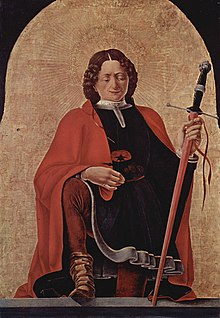Saint Florian: Difference between revisions
Owain.davies (talk | contribs) add reflist |
Owain.davies (talk | contribs) add symbolism |
||
| Line 2: | Line 2: | ||
[[Image:Francesco del Cossa 014.jpg|thumb|Saint Florian, 1473 painting by [[Francesco del Cossa]].]] |
[[Image:Francesco del Cossa 014.jpg|thumb|Saint Florian, 1473 painting by [[Francesco del Cossa]].]] |
||
[[Image:FIRELOGO.gif|right|thumb|280px|Typical St. Florian's cross]] |
|||
'''Saint Florian''' ([[Latin]]: ''Florianus'') (died ca. [[304]]) is a [[Christian]] [[saint]], and the [[patron saint]] of [[Poland]], [[Linz, Austria]], [[chimney sweep]]s and [[firefighting|firefighters]]. His [[feast day]] is [[May 4]]. St. Florian is also the [[patron saint|patron]] of [[Upper Austria]], jointly with [[Saint Leopold]]. |
'''Saint Florian''' ([[Latin]]: ''Florianus'') (died ca. [[304]]) is a [[Christian]] [[saint]], and the [[patron saint]] of [[Poland]], [[Linz, Austria]], [[chimney sweep]]s and [[firefighting|firefighters]]. His [[feast day]] is [[May 4]]. St. Florian is also the [[patron saint|patron]] of [[Upper Austria]], jointly with [[Saint Leopold]]. |
||
| Line 16: | Line 17: | ||
The [[Austria]]n town of [[Saint Florian, Austria|St. Florian]] is named after him. According to legend, his body was interred at the [[Monastery]] of St. Florian. |
The [[Austria]]n town of [[Saint Florian, Austria|St. Florian]] is named after him. According to legend, his body was interred at the [[Monastery]] of St. Florian. |
||
==Symbol== |
|||
The cross of St. Florian is widely used by fire services to form their emblem |
|||
==References== |
==References== |
||
Revision as of 15:37, 3 June 2007

Saint Florian (Latin: Florianus) (died ca. 304) is a Christian saint, and the patron saint of Poland, Linz, Austria, chimney sweeps and firefighters. His feast day is May 4. St. Florian is also the patron of Upper Austria, jointly with Saint Leopold.
Life
Florian lived in the time of the Roman emperors Diocletian and Maximian, and was commander of the imperial army in eastern Bavaria, Germany. In addition to his military duties, he was also responsible for organizing firefighting brigades. [1] The Roman regime sought to eradicate Christianity, and sent Aquilinus to persecute Christians. When Aquilinus ordered Florian to offer sacrifice to the pagan Roman gods in accordance with Roman religion, he refused, and cheerfully accepted the beatings of the soldiers, who used clubs, spikes and fire to torture him. He was executed by drowning in the Enns River with a stone tied around his neck. Later a woman named Valeria had a vision in which she saw him; Florian, in this vision, declared his intent that he be buried in a more appropriate location.
The Austrian Floriani Principle is named after a (somewhat cynical) prayer to Saint Florian: "O heiliger St. Florian verschon mein Haus, zünd andre an", translating to "O holy Saint Florian, spare my house, kindle others".
Burial
St. Florian's body, according to tradition, is buried in Kraków, Poland.
The Austrian town of St. Florian is named after him. According to legend, his body was interred at the Monastery of St. Florian.
Symbol
The cross of St. Florian is widely used by fire services to form their emblem
References
See also
St. Florian's Church in Krakow. The resting place of St. Florian's relics.
